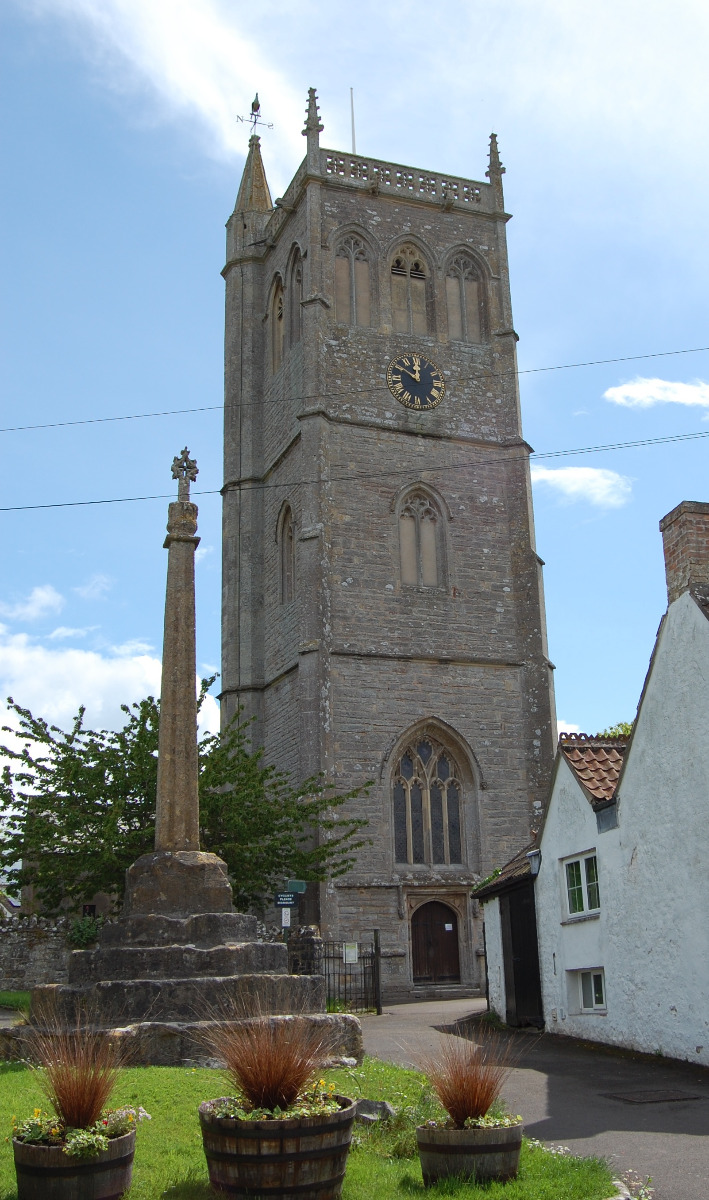Church Guide
Welcome to the Church of St Peter and St Paul, Bleadon. This booklet is intended to help you trace a little of the progress of the building through the centuries to the present day.
There is good reason to believe that there was a church on this site in Saxon times, although nothing remains, except perhaps the little stone angel set high in the arch on the north wall.
The double dedication of St Peter & St Paul was commonly used for Saxon churches because then the two saints shared the same feast day. The fact that our church bears this double dedication certainly indicates an early Christian foundation.
There is an Anglo-Saxon Charter for Bleadon dated 956 by which the boundaries of the parish are defined and there does appear to be a reference to a "church site".
When the Domesday Book was compiled Bleadon was noted as "appelled to the use of the Refectory of the Monastery of Winchester". This was a result of a gift by Githa, wife of Earl Godwin and mother of King Harold, who gave Bleadon to Winchester in 1053. It remained in the gift of the Bishop of Winchester until May 1852 when Patronage was transferred to the Bishop of London. In 1903 advowson passed to Miss E Galloway and one year later Mrs Zara David of Bleadon became Patron. Mrs David passed the Patronage to the Guild of All Souls in 1927 where it remains to date.
This guide starts by the font and leads the reader in a clockwise direction around the interior of the church and in an anti-clockwise direction after leaving by the south door.
The Font
 The font is said to be a Norman tub font. The pedestal and steps on which the bowl is supported are later and were probably added when it became custom to baptise infants by pouring water over them.
The font is said to be a Norman tub font. The pedestal and steps on which the bowl is supported are later and were probably added when it became custom to baptise infants by pouring water over them.
The Screen at the West End
The oak screen dividing the vestry from the nave was set in place in 1953 when the organ was removed from this site. The three shields symbolise the crossed keys of St Peter and the crossed swords of St Paul; and the Cross of St Andrew (signifying the Diocese of Bath and Wells). The screen is the work of Messrs Robinson of Kingston-upon-Thames who, during the same period, supplied new doors throughout the church together with the oak sanctuary tables.
The glass and aluminium screen, which fills the archway above, was installed as a memorial to Mr George Goodman who served over 55 year as a verger. (It will be noted from the brass plate near the pulpit that his predecessor served almost as long. Between them they spanned a century).
The Tower (Internal)
 The tower at the west end of the church was added in the early 15th century. A glimpse of a pleasant stone vaulted ceiling can be seen through the vestry screen. The tower is officially described as "Perpendicular of the triple windowed class".
The tower at the west end of the church was added in the early 15th century. A glimpse of a pleasant stone vaulted ceiling can be seen through the vestry screen. The tower is officially described as "Perpendicular of the triple windowed class".
The Bells
The exact date of any bells being hung is not known but may have been as early as the first half of the 17th century. The massive oak bell frame has a date of 1627 on one of the king posts. This frame still holds the present ring of six bells and although now tie bolted, is in sound condition.
It is known that five of the six bells were cast by Edward Bilbie in 1711 and the sixth in 1925 by the famous Whitechapel Foundry. These five bells were re-hung in 1984 on metal instead of wooden headstocks and ball bearings rather than plain bearings, thus making the bells easier to handle.
The unusual feature is that the bells are hung in an anti-clockwise direction; a curious phenomenon shared with Crowcombe, on the Quantocks, and Bath Abbey.
The heaviest bell is the tenor weighing 10 cwt, a mere lightweight when compared with the tenor of Wells Cathedral at almost 3 tons. Some of the bells have inscriptions on them:
- Treble - Mears & Stainbank Founders London, L T Powys-David Rector, C Tutton & A Amesbury Churchwardens 1925
- 2nd - Bilbie 1711 OQIC OVCWO
- 3rd - No inscription
- 4th - No inscription
- 5th - No inscription
- Tenor - When all we were cast, Bilbie cast wee 1711, John Champion Vmpfry Champion, Churchwardens
Bleadon 700 Banners
 In 1997 a year of celebrations was arranged to mark the 700th anniversary of the first known priest being appointed to Bleadon. As part of these celebrations a local artist, John Hickley, made the four banners which decorate the church so beautifully. A full explanation of the banners is on a separate sheet near the exit.
In 1997 a year of celebrations was arranged to mark the 700th anniversary of the first known priest being appointed to Bleadon. As part of these celebrations a local artist, John Hickley, made the four banners which decorate the church so beautifully. A full explanation of the banners is on a separate sheet near the exit.
Arches in the North Wall
The two arches in the north wall are a little puzzling. Investigation has failed to reveal any foundations to suggest that there had ever been a building here. It almost seems as though a building scheme was started and abandoned. The little stone angel with the shield is very early, possibly Saxon. The lower head is of the 13th or early 14th century.
The tiles in the arch also date from that period and were dug up from the churchyard at the eastern end of the church. It is probable that they once formed the floor of the 1317 chancel. Among the heraldic designs are the Royal Arms of England. King Richard I (Gules, 3 leopards passant, guardant, or) and the arms of the De Clare family (or, 3 chevrons gules). The De Clares were successive Earls of Gloucester.
A painting of the Madonna and Child adorns the blind doorway. This was painted by local artist, Warren Storey, to enhance the church during the Bleadon 700 celebrations.
The Pulpit
The pulpit carved with Tudor flowers and vines, dates from about 1460.
It is one of about 60 medieval stone pulpits which remain in England. It is interesting to note that it was not until 1605 that churchwardens were required to install pulpits in churches.
Rood Loft
The only visible remains of the rood screen, which was removed in 1808, is the little stairway behind the pulpit. The oak doors, studded with antique nails, were fitted during the 1953 restoration work. A portion of carved wood from the old screen does duty as an over-mantel in a local cottage to this day.
The Organ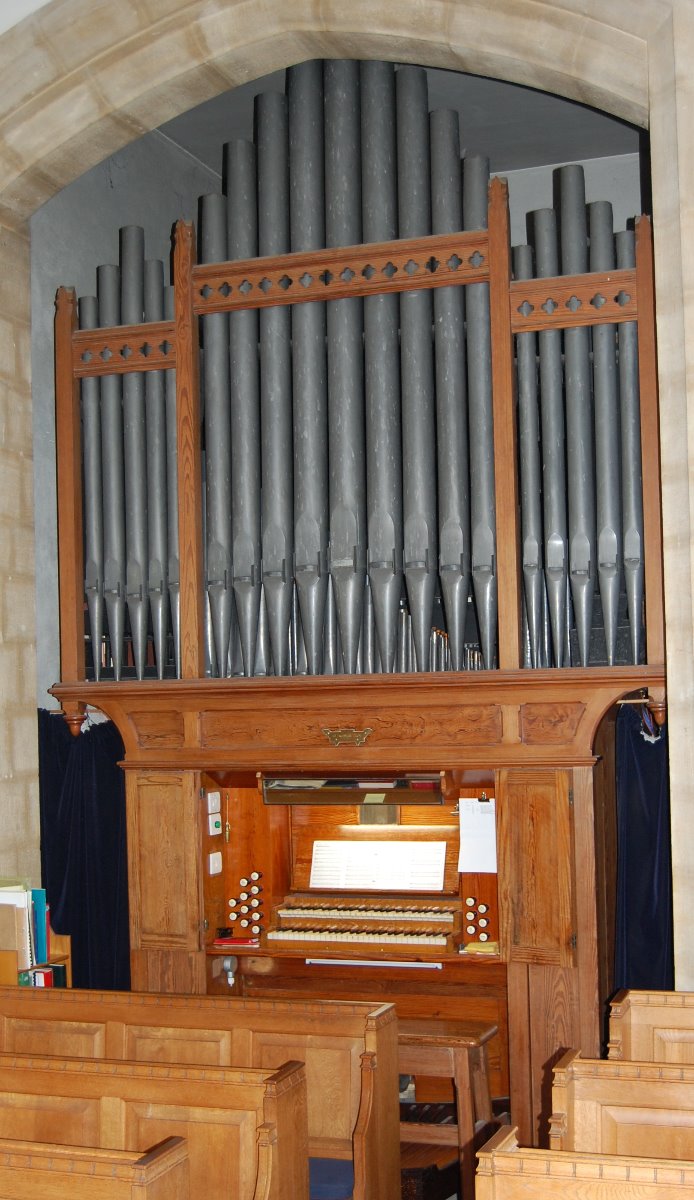
The plate above the console shows that the organ was built by Messrs Sweetland of Bath in 1893. It stood at the west end of the church until 1956 when a chamber was built to accommodate it on the north side of the chancel. The original intention was to build a north side aisle which would have allowed the organ to speak freely throughout the church, but unfortunately this project did not come to fruition with the result that the sound of the organ is considerably constricted.
In 1975 the organ was overhauled by Messrs Percy Daniel & Co Ltd of Clevedon. At the same time the Great Harmonic Flute and Dulciana were replaced by a Principal and a Fifteenth and the Pedal Bourdon was extended to provide a Bass Flute. Sad though the loss of the only 4 ft flute was, it was clear that the changes were necessary to increase the volume projected from the organ's confined position.
The organ is unusual in that it has three types of action: mechanical on the Great, pneumatic on the Swell and electric on the Pedal. The present specification is as follows:
| Great Organ | Couplers |
| Open Diapason 8 | Swell to Great |
| Stopped Diapason 8 | Great to Pedal |
| Principal 4 | Swell to Pedal |
| Fifteenth 2 | Swell Octave |
| Swell Sub Octave | |
| Swell Unison Off | |
| Swell Organ | Pedal Organ |
| Open Diapason 8 | Bourdon 16 |
| Lieblich Gedacht 8 | Bass Flute 8 |
Principal 4 | |
Nazard 2 2/3 | |
Oboe 8 |
The Chancel
 This is the oldest part of the present building and is recorded as having been dedicated in 1317. At that time the east wall was some twelve feet further east and there was a Sacristy at the north-east corner connected to the chancel by a door. Traces of this doorway are still visible in the outside wall. The subsequent shortening of the chancel accounts for the way in which the canopied tomb on the right of the alter is cramped against the east wall. The stone slab covering the tomb was lifted some years ago and a stone coffin was revealed.
This is the oldest part of the present building and is recorded as having been dedicated in 1317. At that time the east wall was some twelve feet further east and there was a Sacristy at the north-east corner connected to the chancel by a door. Traces of this doorway are still visible in the outside wall. The subsequent shortening of the chancel accounts for the way in which the canopied tomb on the right of the alter is cramped against the east wall. The stone slab covering the tomb was lifted some years ago and a stone coffin was revealed.
Set in the wall on the left of the altar is the aumbry. The modern lamp, which hangs above, denotes the presence of the reserved sacrament.
The wooden reredos, altar rail and pictures were given by the Rev'd Powys-David in memory of his wife and sister-in-law. The pictures are copies of known works.
The Priest's door on the south side of the chancel has an attractive stone canopy, which incorporates a small monkey-like corbel head on the western side.
The East Window
This window was designed by Miss Marion Grant and erected in 1964 by the people of Bleadon.
The little figure of a nun, which is her 'signature', may be seen low down in the left hand light.
Extracts from the notes by Miss Grant give us an insight into her approach to the work.
Our Lord Ascended into Glory
The subject for an east window is inseparable from worship at the celebration of Holy Communion for, architecturally, the east window was intended to form the reredos of the altar in the majority of English churches. Therefore the presentation of an east window subject offers lines of approach and meditation without limit. In this window the lines of thought are developed as follows:
Central Light
The main theme starts at the top with God the Father and Creator, without whom nothing starts at all. The traditional symbol of the Hand of God is used. All around are rays of Divine Glory, clouds, sun, moon and stars. The third member of the Holy Trinity is depicted by the Holy Dove described at the baptism of out Lord. Rays of Glory descend from the Father to the Holy Ghost and to God the Son.
As described by St John the Divine in his Book of Revelation the ascended Christ is enthroned in the Glory, seated on a rainbow, on which is inscribed IC XC NIKA (Jesus Christ Triumphant). His feet rest on the orb, symbol of the universe, under the Divine Power of God's unceasing creation. About Him are Seraphim representing spiritual love (and therefore by tradition red in colour) and Cherubim representing intellectual love (blue). He is Alpha and Omega.
At the foot of the central light and just above the altar cross, the Pelican in Piety is shown. Its origin as the symbol of sacrifice is lost in ancient ecclesiastical art. Rather than let her young die, the pelican pecks herself in order to feed them on her life's blood, and by the same tradition her nest resembles the Crown of Thorns.
Rising above the Pelican is the Citadel of the Holy City described in the Book of Revelation. The Tree of Life, whose leaves were for "the healing of the nations", stands in the waters of life.
Left hand light - The Blessed Virgin Mary.
Our Lady is shown in adoration opposite St John the Baptist.
Below her is her own emblem, the lily and the Star of the Nativity.
Above, at the top of the light, St Gabriel, Angel of the Annunciation, holds a plaque bearing her name.
Right hand light - St John the Baptist.
St John the Baptist is shown in adoration at the foot of the Throne, clad in the rough garments of one whose service to God impelled him to live from hand-to-mouth in a wilderness of need and suffering.
Below St John, bearing the banner of the Resurrection, is the Lamb, symbol of the Risen Lord, whose coming John went forth to proclaim. The Lamb is supported by the book with seven seals as described in the Book of Revelation.
At the top of the light St Michael is displaying the feathered armour and flaming sword of the Guardian Archangel of the Heavens. He hold a plaque bearing the monogram of St John the Baptist.
The wording "Even so in Christ shall all be made alive" completes the presentation.
Millennium/Arthur Cullen Window (south side of the sanctuary)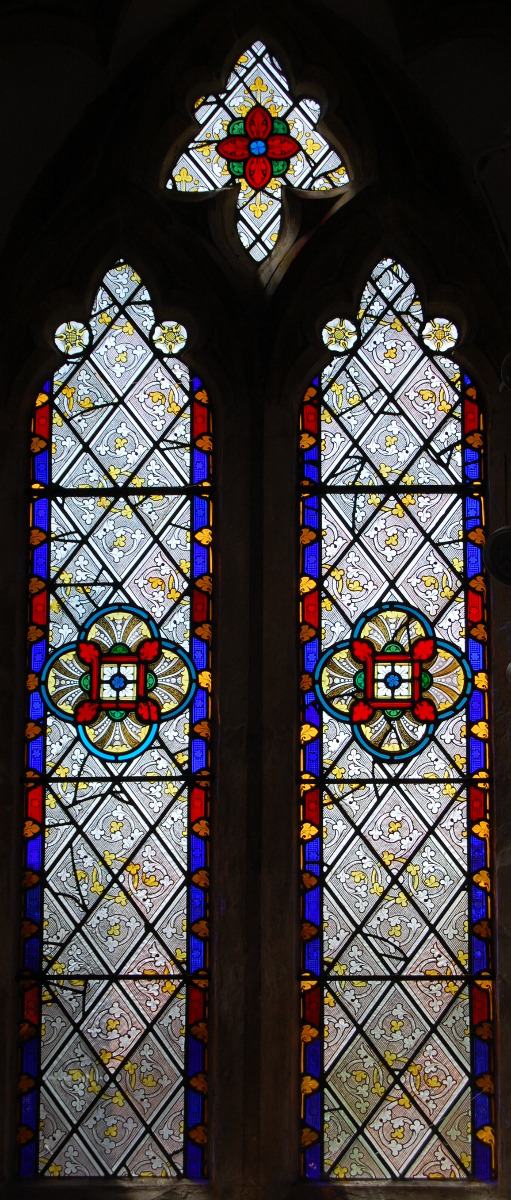
During some clearance work in the bier house garden the remains of an old stained glass window were discovered and rescued.
This was thought to have been removed from the north side of the chancel when the organ chamber was built.
To mark the start of the new Millennium and as a tribute to one of the previous churchwardens, the PCC decided to have the window re-made and installed in its present position.
Low side window
Immediately to the west of the Priest's door is a window with its sill much lower that the rest. This is known as a low side window. The Priest's stall was usually sited in front of this window, which had opening lights to allow the Sanctus bell, situated on the south side of the chancel, to be rung at the Elevation during the Mass.
We know that the chancel was shortened by twelve feet and we believe that the original chancel with choir would have been east of the Priest's stall, and to the west would have been a central tower and a crossing, forming a cruciform church. The external south wall shows signs of infilling, no doubt carried out when the central tower collapsed, as so many of them did.
The Porch
 The focal point of the south porch is the attractive stone carving set in the niche on the east wall. This was uncovered when plaster was removed during renovations in 1854. It is thought from the style and dress to date from around 1370.
The focal point of the south porch is the attractive stone carving set in the niche on the east wall. This was uncovered when plaster was removed during renovations in 1854. It is thought from the style and dress to date from around 1370.
The central figure is the Blessed Virgin Mary carrying the Holy Child. At her feet on either side are two figures in medieval costume in the attitude of adoration. The man wears at his right side an analace or short sword, which was characteristic of the period.
The two headstone, placed here for preservation, are interesting examples of local work. Both appear to be done by the same hand and the lettering shows certain peculiarities, notably the capital D and the figure 4 in the date 1649.
The stone on the west side commemorates Joan, the five year old daughter of John and Anne Sheppard of Christon, who died in 1649. The decorative work is of the crudest kind, the head reminding one of "Chad" of the cartoons. It is claimed that this represents a skull and the two crossed objects are crossed bones. There are also some simple flowers. It may be worth remembering that in Somerset great use was made of simple symbols to ward off evil spirits. According to R L Tongue in her book "Somerset Folklore", crossed pins and primroses were commonly used.
The second stone commemorates John Keen, yeoman, who died in1678, and the inscription reads:
The pains are high
that I do feel
my friend I long to see
my days on earth are
very short, lord take
my soul to thee.
Exterior - South Side
Walk east along the path on the south side of the church and you will see, low down on a buttress midway along, a scratch dial. A semi-circle of rays points downwards from the central peg-hole. This would have been the Mass dial to indicate the time of service. A little further on three stone heads decorate the drip stone of the window. One is grimacing horribly with his tongue lolling and eyes protruding. High on the buttress, east of the Priest's door, there are traces of a sundial.
Exterior - North Side
At the eastern end can be seen the traces of the Chantry doorway. Past the organ chamber to the west are the outward signs of the north arches, and blocked doorway, which does not appear inside the church. Two heads, one bearded, decorate the drip-stone of the window beside the tower stairs.
The roof was repaired in 1953, removing lead dated 1753. It was replaced with Cornish delabole slates, laid in graduated courses. In 1993 there were repairs to the chancel roof, briefly exposing medieval crafts-men's marks on some of the timbers. A pectoral cross carved by a local craftsman from the part of the old timber was presented to Bishop Jim Thompson at a Thanksgiving Service to mark the end of the restoration.
The Tower (external)
The tower is some 80 feet in height and has three chambers: Ringing chamber, clock chamber and belfry. It is roofed in lead which was renewed in 1962, replacing that dated 1766. It has several interesting gargoyles, in particular the little man in tight hose sitting crossed-legged and playing a form of bagpipes. He can be seen on the left above the clock dial on the west face.
The tower staircase rises on the north-east corner of the tower and is crowned by a weathercock. This is made of gilded copper and was purchased in 1833 when the Churhcwardens'accounts record "Paid Samuel Taylor's bill and weathercock £52 1s 1 1/2p" Experts have described it as a fine example of Folk Art as it is a complete bird with feet and talons. It was stored in the church 1953 to 1996 as the tower was considered unsafe. When the tower was re-pointed and the turret strengthened the weathercock was re-gilded and replaced. This was made possible by the Bleadon Players who raised the necessary funds.
The square drip stone over the west door terminates with two symbolic heads, one mitred and the other crowned, signifying spiritual and temporal power.
The Clock
The clock was installed as a result of public subscription to commemorate the Diamond Jubilee of Queen Victoria. Its original cost was about £200. It has been described as "a lovely little mechanism" and was made by Smiths of Clerkenwell and supplied by W E Perrett, whose name appears on the dial.
The copper convex dial is seven feet in diameter and is placed approximately 70 feet above the ground. In 1963 the clock was restored, again by public subscription at a cost of £204.
In 1996 the hawsers supporting the heavy weights were found to be fraying and unsafe. It was decided to convert the clock to automatic winding. Once again the people of Bleadon subscribed the money and the work was completed in January 1997 by Smiths of Derby.
The Cross Outside the Main Gate
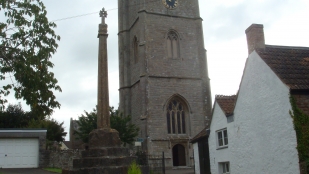 No doubt when it was erected the cross stood within the churchyard boundary. The earliest portions, from the late 14th century, are the four tiers of octagonal steps and the socket for the shaft. This socket is hewn from a solid block of stone. The fluted shaft is dated at least three centuries later and the finial is comparatively modern.
No doubt when it was erected the cross stood within the churchyard boundary. The earliest portions, from the late 14th century, are the four tiers of octagonal steps and the socket for the shaft. This socket is hewn from a solid block of stone. The fluted shaft is dated at least three centuries later and the finial is comparatively modern.
The cross has suffered through the years, being strcuk by lightning in1827 and restored by the Rev'd David Williams. It was later attacked by the young vandals of the day and the Rev'd Robert Lawrence bore the cost of the repair. More recently, the Parish Council has repaired and replaced the finial.
Imagine the scenes which have taken place around the cross. It would have formed a focal point for itinerant preachers, rough justice and, no doubt buying and selling in its early years.
Details of some incumbents through the centuries.
1297 - Richard Pay.
While it is highly probable that there were other priests who preceded him, Richard Pay is the first recorded name that we have.
1501 - 1540 - Blessed Edward Powell - Priest and Martyr.
Edward Powell, born in Wales about 1478, was a Fellow of Oriel College, Oxford, where he took his Doctorate of Theology in1506. He accepted the living of Bleadon near Weston-super-Mare, became a prebendary of St Mary, Redcliffe, Bristol, and was given other preferments.
After the accession of Henry VIII he became a frequent preacher at Court. Powell took an active part in opposing the spread of Luther's doctrines by writing three books. He was one of the learned divines who spoke against Henry's divorce from Catherine of Aragon, and is said to have been one of Catherine's advocates at her trial.
From this time he was out of favour at Court. When Latimer was invited to preach before the Corporation of Bristol in March 1533, Powell was put forward by the Bristol clergy to answer him. Some accounts say he preached on College Green. Latimer complained to Cromwell, and Powell replied by denouncing the King's marriage to Ann Boleyn.
In 1534 he was arrested, brought to trial and condemned for refusing to take the Oath of Succession. He was deprived of all his preferments (except it seems the living of Bleadon, where he is listed as Rector until his death) and committed to the Tower, where he remained for six years.
In 1540 he was attainted for so-called treason, for denying Henry's supremacy over the church, and "adhering to the Bishop of Rome". On 30th July in that year he was hung, drawn and quartered at Smithfield with two other priests, Blessed Thomas Abel, chaplain to Catherine of Aragon, and Blessed Richard Fetherston, tutor to the Princess Mary, daughter of Catherine. They were beatified by Pope Leo XIII in 1886.
It is interesting to recall that three Protestant divines were put to death at the same time and place by burning. One of these was Dr Robert Barnes.
1780 - 1788 - William Norman.
Obituary in the Gentleman's Magazine 1788.
"Suddenly of a suffocation, the Rev W Norman Rector of Bleadon, Somerset.
"Rev W Norman Rector of Bleadon Co Somerset as he was sitting at supper (on the 25th) with a friend, he observed his brother, the Rev Henry N take a large knife from the case and go into the kitchen. He immediately called to the servant to take it from him, which through fear he omitted to do. Soon after, Henry returned to the Parlour, with the knife concealed under his coat, and, unobserved by his brother, came behind him and stabbed him twice. The unfortunate gentlemen lay in the greatest agonies of pain till the evening of the 27th when he expired.
"The wretched perpetrator of this horrid act is Rector of Morsted, near Winchester, and having been some time deranged in his intellects, was removed to his brother at Bleadon, for security and in August last appeared in a more serene state than for some years before. He therefore had greater liberties allowed him and the tragical event happened as above related. The unhappy maniac, we are told, being asked by his servant when he should return home, gave the answer "As soon as he had killed his brother". No notice was taken of this. He has since been confined to a private mad house.
1820 - David Williams.
According to an account by "Churchgoer" David Williams was somewhat remiss in his parochial cares and in different in his conduct of services. However, he was a keen archaeologist and geologist and we are indebted to him for a unique collect of animal bones and fossils discovered in and around Bleadon. He is described by a contemporary as of huge build, with a farmer-like face and a head full of stanzas and antiquities of Somerset.
1911 - 1952 - Lionel Powys-David.
Lionel Powys-David was Rector of Bleadon from 1911 until his death in 1952. He was held in great affection and respect by the parish. Old and young alike enjoyed the parties hosted by him and his wife in the old Rectory in winter and in the garden in summer.
The legacy which he left to the church was used in 1956 to move the organ from beneath the tower to the new organ chamber north of the choir stalls, as a memorial.
**********************
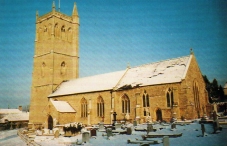
We acknowledge with thanks the following contributors:-
W. Storey - Drawings
P Maffey - The Bells
D Elliott - Stage II Restoration
D Lowton - The Organ.

